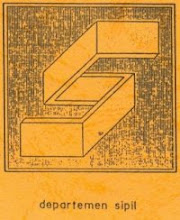Selasa, 20 September 2011
Prestressed Concrete
prestress is usually imparted to a concrete member by highly tensioned steel reinforcement (wire, strand, or bar) reacting on the concrete. The highstrength prestressing steel is most often tensioned using hydraulic jacks. The tensioning operation may occur before or after the concrete is cast and, accordingly, prestressed members are classified as either pretensioned or post-tensioned.
Pretensioned concrete
The prestressing tendons are initially tensioned between fixed abutments and anchored. With the formwork in place, the concrete is cast around the highly stressed steel tendons and cured. When the concrete has reached its required strength, the wires are cut or otherwise released from the abutments. As the highly stressed steel attempts to contract, the concrete is compressed. Prestress is imparted via bond between the steel and the concrete. Pretensioned concrete members are often precast in pretensioning beds long enough to accommodate many identical units simultaneously. To decrease the construction cycle time,
steam curing may be employed to facilitate rapid concrete strength gain and the concrete is often stressed within 24 hours of casting. Because the concrete is usually stressed at such an early age, elastic shortening of the concrete and subsequent creep strains tend to be high. This relatively high time-dependent shortening of the concrete causes a significant reduction in the tensile strain in the bonded, prestressing steel and a relatively high loss of prestress.
Post-tensioned concrete
With the formwork in position, the concrete is cast around hollow ducts which are fixed to any desired profile. The steel tendons are usually in place, unstressed in the ducts during the concrete pour, or alternatively may be threaded through the ducts at some later time. When the concrete has reached its required strength, the tendons are tensioned. Tendons may be stressed from one end with the other end anchored or may be stressed from both ends.
The tendons are then anchored at each stressing end. The concrete is compressed during the stressing operation and the prestress is maintained after the tendons are anchored by bearing of the end anchorage plates onto the concrete. The post-tensioned tendons also impose a transverse force to the member wherever the direction of the cable changes. After the tendons have been anchored and no further stressing is required, the ducts containing the tendons are often filled with grout under pressure. In this way, the tendons are bonded to the concrete and are more efficient in controlling cracks and providing ultimate strength. Bonded tendons are also less likely to corrode or lead to safety problems if a tendon is subsequently lost or damaged. In some situations, however, particularly in North America and Europe, tendons are not grouted for reasons of economy and remain permanently unbonded. Most in situ prestressed concrete is post-tensioned. Relatively light and portable hydraulic jacks make on-site post-tensioning an attractive proposition. Post-tensioning is also used for segmental construction of large-span bridge girders. Prestress may also be imposed on new or existing members using external tendons or such devices as flat jacks. These systems are useful for temporary prestressing operations but may be subject to high time-dependent losses.
Langganan:
Posting Komentar (Atom)
About Me
Related Links
Label
- Concrete (1)
- Mechanics Statics (1)
- Soil Mechanics (3)
- Surveying (9)
Diberdayakan oleh Blogger.

0 komentar:
Posting Komentar